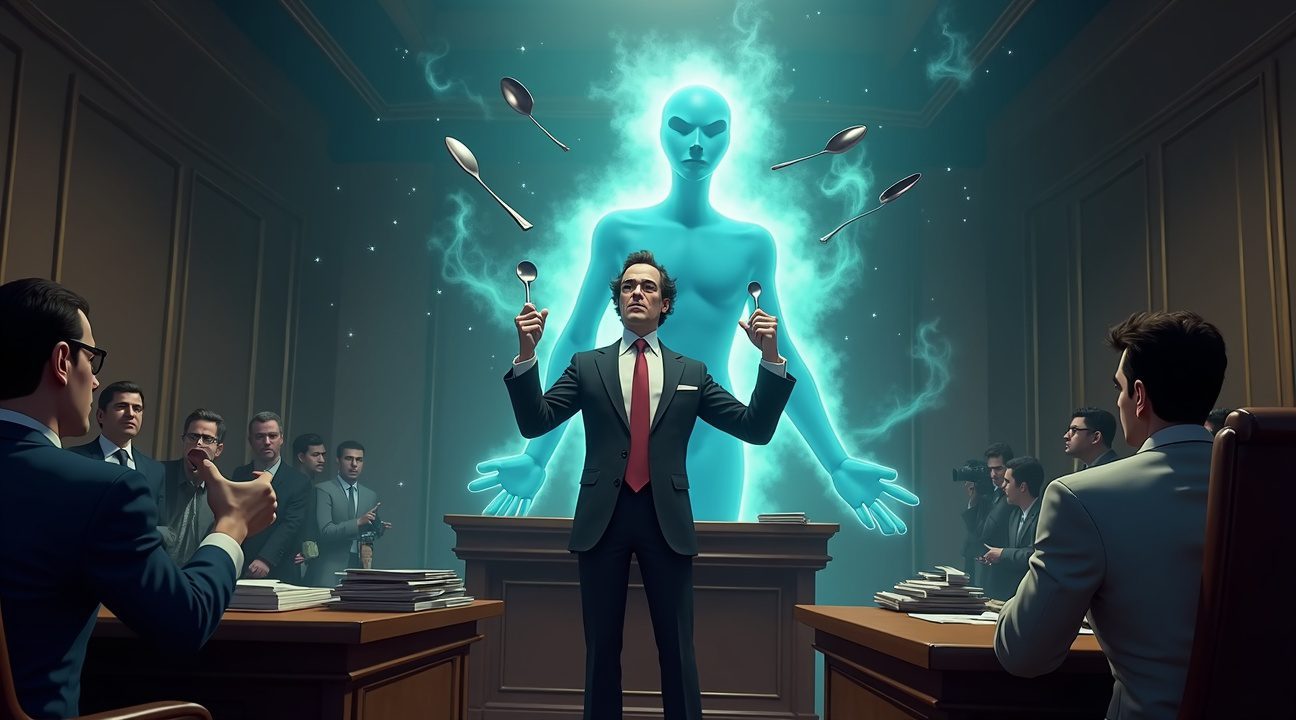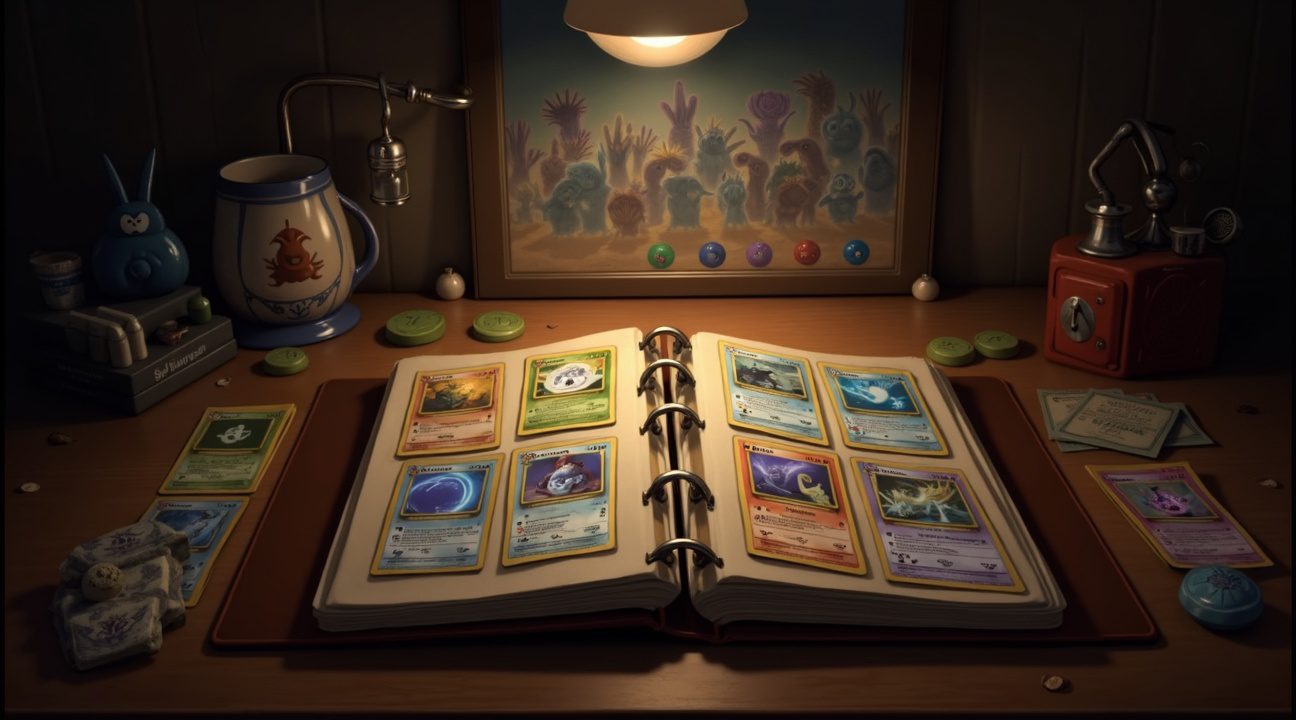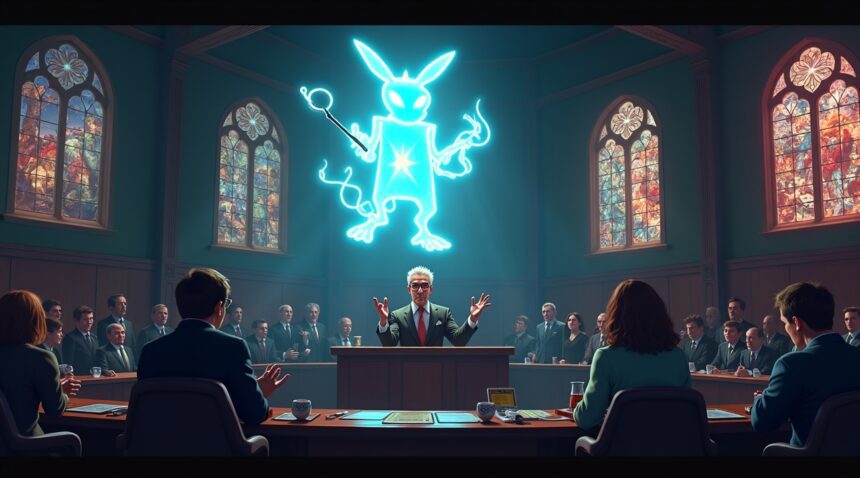Uri Geller, the famous spoon-bending mentalist, achieved an unprecedented victory against Nintendo by successfully removing Kadabra from Pokémon TCG production for over 20 years through his $60 million lawsuit claiming unauthorized use of his likeness.
His legal action stemmed from the notable similarities between Kadabra’s Japanese name “Yungerer” and Geller’s own surname, as well as the character’s spoon-bending psychic powers that mirrored his iconic performances. As a result, one of the most recognizable Psychic-type Pokémon was removed from new card releases for two decades, until Geller issued a public apology and granted permission for Kadabra’s return in 2020. The character made its long-anticipated comeback in 2023, much to the excitement of fans around the world.
Key Takeaways
- Geller’s legal action led to Kadabra’s removal from the Pokémon Trading Card Game from 2002 to 2023, setting a record as the longest character absence in TCG history due to litigation.
- The issue centered around Kadabra’s original Japanese name, “Yungerer”, which closely resembled Uri Geller’s name, combined with spoon-bending abilities that mimicked his famous stage acts.
- Nintendo had to adapt Kadabra’s absence in gameplay by enabling Abra to evolve directly into Alakazam, leading to a unique change in evolution dynamics lasting 20 years.
- Geller issued a public apology in 2020 after receiving messages from fans and being influenced by his granddaughters, thus allowing Kadabra’s reappearance in trading cards.
- Kadabra finally returned in the Pokémon Card 151 set, reuniting the entire Abra evolutionary line for the first time since the early 2000s and sparking widespread celebration among Pokémon collectors.
More about this controversy and Kadabra’s return can be found in Polygon’s in-depth report covering the full timeline of events.
The Spoon-Bending Magician Who Banned a Pokemon Card
Uri Geller’s entrance into Pokemon card game history reads like something from a fantasy novel, yet this celebrity psychic genuinely managed to influence one of gaming’s most popular franchises through legal action. In 2000, the famous mentalist who captivated audiences worldwide with his alleged ability to bend spoons using only his mind decided that Nintendo had crossed a line with their Pokemon character Kadabra.
Geller filed a lawsuit demanding $60 million in damages, claiming that Kadabra was an unauthorized representation of his identity and likeness. His argument centered on several compelling similarities between himself and the psychic-type Pokemon. The character’s Japanese name, “Yungerer” or “Yungeller,” bore an unmistakable resemblance to his own surname. More significantly, Kadabra’s signature ability involved bending spoons telepathically – the exact same feat that had made Geller a household name since the 1970s.
The lawsuit presented an unprecedented situation in the trading card game industry. While Pokemon cards had been removed or modified before due to gameplay balance issues or trademark disputes, no celebrity had ever successfully challenged Nintendo based on personal likeness claims. Geller’s case stood apart because it wasn’t about corporate intellectual property or game mechanics – it was about a real person’s image being allegedly appropriated for commercial gain.
Legal Battles Across Multiple Jurisdictions
Although the case was dismissed in the United States in 2003, Geller didn’t abandon his legal pursuit. He continued filing actions against Nintendo in various international markets, creating a prolonged legal headache for the gaming giant. The mentalist’s persistence demonstrated his serious commitment to protecting what he viewed as his intellectual property rights.
Geller’s high profile as a television performer and stage magician brought significant public attention to the case. His appearances on major talk shows and his controversial claims about supernatural abilities had already made him a polarizing figure in popular culture. When he targeted one of the most beloved franchises in gaming, the story captured media attention far beyond typical legal disputes.
The impact on Pokemon card collecting became immediately apparent. Nintendo’s response was swift and decisive – they essentially banned Kadabra from appearing in new Pokemon card sets. This meant that while players could still use existing Kadabra cards in tournaments and casual play, no new versions would be printed for the foreseeable future.
The situation created a unique phenomenon where a single lawsuit effectively removed a beloved Pokemon from active card production. Collectors began hoarding existing Kadabra cards, knowing that their rarity would only increase over time. The artificial scarcity drove up prices for vintage Kadabra cards, particularly those from the original Base Set and subsequent early expansions.
For competitive players, Kadabra’s absence created strategic implications. The psychic-type Pokemon had served as a crucial evolution step between Abra and Alakazam, two powerful cards in various deck archetypes. Players had to adapt their strategies and find alternative evolution pathways or different Pokemon altogether.
Geller’s victory, though not financial, proved remarkably effective. His legal pressure succeeded where many corporate disputes fail – he forced a major entertainment company to alter their product line permanently. The case became a cautionary tale for game developers about the importance of avoiding even perceived similarities to real people when creating fictional characters.
The mentalist’s reputation within Pokemon trading card game circles remains complex. Some players respect his successful defense of his image rights, while others view him as someone who unnecessarily interfered with their beloved game. Regardless of personal opinions, Geller undeniably changed Pokemon card game history through sheer determination and strategic legal action.

Geller’s Specific Claims Against Kadabra’s Design
Geller launched several pointed accusations against Nintendo and The Pokémon Company regarding Kadabra’s design elements. His primary complaint centered on the character’s Japanese name, “Yungerer” or “Yungeller,” which he insisted constituted a direct reference to his own surname. This wasn’t merely a casual observation—Geller viewed the naming as an intentional attempt to capitalize on his fame without permission.
Physical Design Elements and Symbolic Interpretations
Beyond the naming issue, Geller took particular offense at specific visual elements featured on Kadabra’s card and character design. He pointed to the prominent star adorning Kadabra’s forehead and the lightning-like symbols scattered across the Pokémon’s body. These markings, according to Geller, weren’t innocent design choices but rather carried darker implications.
Geller’s most controversial assertion involved comparing these symbols to occult imagery. He escalated his claims dramatically by suggesting the lightning-like patterns resembled those of the Nazi SS, an accusation that sparked significant controversy within the gaming community. “Nintendo turned me into an evil occult Pokémon character,” Geller stated, expressing his belief that the company had deliberately transformed his public image into something sinister.
Alternative Explanations and Creator Intent
Nintendo and The Pokémon Company never officially acknowledged Geller’s interpretations of the design elements. Some sources suggest that Kadabra’s symbols actually reference Zener cards, which are commonly used in scientific testing for extrasensory perception (ESP). This explanation would align more naturally with Kadabra’s psychic-type abilities and the broader theme of mental powers within the Pokémon universe.
The creators haven’t provided official explanations that support Geller’s accusations about deliberate caricature or malicious intent. Geller interpreted every design choice through the lens of personal attack, believing that Kadabra represented a calculated effort to misrepresent him in a disturbing manner. His conviction that the character served as a harmful caricature of his image became the foundation for his legal challenges against the franchise.
This interpretation gap between Geller’s perception and the company’s silence created a lasting tension that would influence Pokémon TCG card availability for years. While players and collectors continued to enjoy the broader Pokémon universe, Geller’s ongoing dispute with the franchise creators marked the beginning of a complex legal and cultural phenomenon that extended far beyond simple trademark concerns.
Twenty Years in TCG Exile
Following the legal dispute, Kadabra was effectively banned from the Pokémon Trading Card Game after 2002. The character stopped appearing in card sets after the Team Rocket expansion, creating an unprecedented situation where a middle-evolution Pokémon simply vanished from official releases. This absence forced Pokémon to develop creative workarounds that fundamentally altered how one of the franchise’s most recognizable evolution lines functioned.
Adaptive Gameplay Solutions
To adapt, Pokémon released Abra cards that evolved directly into Alakazam, bypassing Kadabra entirely. Text on some cards referenced Kadabra only in the evolution description, but the character itself was left out of actual card production. The most notable example appeared in the 2007 Diamond & Pearl: Mysterious Treasures set, where an Abra card evolved straight into Alakazam without any visual representation of the missing middle stage.
This workaround created unusual dynamics in both gameplay and collecting that rippled through the TCG community for decades. Players had to adjust their strategies around incomplete evolution lines, while collectors found themselves with gaps in what should have been complete sets. The absence became so normalized that newer players often didn’t realize a third evolution stage had ever existed.
Collector Market Impact
As a result, Kadabra cards predating the 2002 ban became especially sought after by collectors. These cards transformed from common gameplay pieces into rare artifacts representing a specific era in Pokémon TCG history. Compared to other Psychic-type Pokémon like Abra and Alakazam, Kadabra had a significant drop in card releases, making its legacy distinct during this two-decade absence.
The scarcity created a unique collecting phenomenon where cards from sets like Base Set, Jungle, and Team Rocket commanded premium prices not just for their age, but for their status as the only official Kadabra representations available. Vintage Kadabra cards became time capsules, representing the last era when the complete Abra evolution line existed in the TCG without legal complications.
This twenty-year exile demonstrated how external legal pressures could reshape an entire gaming ecosystem. The Pokémon Company’s ability to maintain the Alakazam line through direct evolution mechanics showed remarkable adaptability, but it also highlighted how one person’s legal claims could fundamentally alter a global entertainment product for two decades.

Geller’s Change of Heart and Public Apology
After nearly two decades of legal prohibition, Uri Geller dramatically reversed his position in late 2020. He issued a public apology for his role in banning Kadabra from the Pokémon TCG and formally granted Nintendo permission to use the character again.
Fan Influence and Family Encouragement
Geller credited passionate fan outreach as a primary catalyst for his change of heart. Years of dedicated Pokémon enthusiasts pleading for Kadabra’s return gradually softened his stance. However, the most compelling influence came from his own family circle. His granddaughters played a particularly crucial role in helping him understand the cultural significance of Pokémon and the disappointment his legal actions had caused among fans worldwide.
The Official Statement
In his public statement, Geller expressed genuine remorse for the extended ban. “I am pleased Pokémon fans are excited to see Kadabra return to the card game,” he declared, acknowledging the enthusiasm surrounding the potential return. He continued with remarkable candor: “it was you and my granddaughters that got me to change my mind.” This admission highlighted how personal relationships and fan dedication had transformed his perspective.
The statement represented a complete philosophical shift from Geller’s earlier litigious approach. Instead of viewing the Uri Geller Pokémon TCG connection as unauthorized exploitation, he began embracing it as a form of cultural tribute. His granddaughters helped him recognize that his association with Pokémon had actually introduced him to an entirely new generation of admirers.
This transformation from adversary to supporter cleared the path for Kadabra’s eventual return to Pokémon merchandise and card sets. Geller’s willingness to publicly admit his mistake and formally grant permission demonstrated genuine character growth. His apology acknowledged the disappointment his actions had caused countless collectors and players who had grown up with the franchise.
The timing of Geller’s announcement couldn’t have been more significant for the Pokémon community. Collectors had spent years hoping for Kadabra’s return, often expressing frustration about incomplete evolution lines in their sets. His change of heart validated their patience and opened exciting possibilities for future card releases featuring the beloved psychic Pokémon.

Kadabra’s Triumphant Return to Pokemon Card 151
In June 2023, the Pokemon Trading Card Game officially welcomed back one of its most conspicuously absent characters when Kadabra appeared in the Pokemon Card 151 set. This marked the psychic Pokemon’s first official trading card appearance in over two decades, ending what many collectors had come to view as the most puzzling omission in the game’s history.
Completing the Evolutionary Circle
The return held special significance because it finally reunited Kadabra with Abra and Alakazam, creating the first complete evolutionary line in TCG form since the early 2000s. For years, collectors had access to the basic Pokemon Abra and the powerful stage-two Alakazam, but the crucial middle evolution remained mysteriously absent from every set. This created an awkward gap that forced players to work around the missing link, often relying on rare candy cards or alternative evolution mechanics to bridge the evolutionary gap between Abra and Alakazam.
I found it particularly striking how the Pokemon Company had managed to maintain Alakazam’s presence in sets while completely avoiding Kadabra for so many years. The creative workarounds became increasingly elaborate, with some sets featuring alternate evolution paths or special conditions that allowed Abra to evolve directly into Alakazam.
Fan Community Celebration
The Card 151 set generated unprecedented excitement among collectors who had been following Kadabra’s unusual legal journey. Social media platforms exploded with celebration posts as fans shared images of the returned character, many expressing disbelief that the long wait had finally ended. The enthusiasm wasn’t limited to casual collectors either – competitive players welcomed back the tactical options that a complete Abra evolution line would provide.
Long-time Pokemon enthusiasts particularly appreciated this return because many had grown up with the original cards from the late 1990s and early 2000s. For them, Kadabra’s absence had always felt like an incomplete chapter in their collecting experience. The character’s return in Card 151 carried emotional weight beyond simple nostalgia, representing the resolution of one of the TCG’s most enduring mysteries.
The timing proved especially meaningful since Card 151 served as a celebration of the original 151 Pokemon from the Kanto region. Having Kadabra missing from such a commemorative set would have felt like a glaring omission, making its inclusion feel both necessary and triumphant. Collectors noted how the set finally felt complete with all original Pokemon represented.
Discussion forums buzzed with speculation about whether this return would extend to future sets or if Kadabra’s appearance might remain limited to special commemorative releases. Many fans expressed hope that this comeback would normalize the character’s presence in regular Pokemon TCG sets moving forward.
The broader impact extended beyond individual collectors to the secondary market, where original Kadabra cards from the early 2000s had developed cult status due to their scarcity in modern sets. The Uri Geller Pokemon TCG controversy had inadvertently created a unique collectible category, and Kadabra’s official return shifted market dynamics significantly.
Card shops reported increased interest in complete evolutionary sets following the announcement, with many customers specifically seeking out the new Kadabra cards to complete collections they had been unable to finish for decades. The return represented more than just another Pokemon card release – it symbolized the resolution of one of the trading card game’s most persistent gaps and demonstrated how legal complexities could unexpectedly shape beloved entertainment properties.
A Unique Landmark in Gaming History
I find the Uri Geller lawsuit against Nintendo and The Pokémon Company stands as one of the most unusual legal disputes in gaming history. The controversy surrounding Kadabra’s removal from the Pokémon Trading Card Game created a precedent that continues to fascinate legal experts and collectors alike. This case demonstrates how intellectual property law can extend far beyond traditional copyright disputes to encompass personal likeness and cultural representation.
An Unprecedented Legal Challenge
The spoon-bending magician’s legal action against the Pokémon franchise broke new ground in entertainment law. Most gaming disputes typically center on technology patents, character designs, or gameplay mechanics stolen from competitors. However, Geller’s claim focused on something entirely different – the alleged unauthorized use of his persona and abilities in creating Kadabra’s character. The Pokémon company faced accusations that the psychic-type Pokémon’s spoon-bending powers directly referenced Geller’s famous performances, creating what he viewed as commercial exploitation without consent.
This intellectual property and trading cards case established that even fictional characters could potentially infringe upon a real person’s public image. The legal implications extended beyond Pokémon, setting a precedent that other entertainment companies carefully studied. Game developers now consider how closely their fictional characters might resemble real individuals, especially when incorporating abilities or characteristics associated with specific public figures.
Cultural Impact and Legacy
The Kadabra Pokémon TCG ban created ripple effects that extended far beyond legal proceedings. Collectors watched as one of the original Pokémon mysteriously vanished from new card releases, creating an unusual gap in the franchise’s completeness. The absence became particularly noticeable when Pokémon Card 151 and similar comprehensive collections were released, leaving fans wondering about the missing psychic evolution.
What makes this situation culturally significant is how it intertwined celebrity objections with beloved childhood entertainment. The Uri Geller Pokémon TCG controversy highlighted the complex relationship between public figures and popular culture representations. Children who grew up with the original Pokémon cards found themselves witnessing an unprecedented intersection of law and entertainment that most gaming disputes never achieve.
The eventual Kadabra return in recent years marked the resolution of one of gaming’s longest-running legal mysteries. The character’s reappearance in official Pokémon products demonstrated that even the most unusual intellectual property disputes can eventually find resolution. This development brought closure to a chapter that had puzzled fans for over two decades.
The case remains memorable because it shows how a single individual’s objections can influence a multi-billion-dollar franchise. Unlike typical corporate battles over technology or market share, this dispute involved personal identity and cultural representation. The situation created a unique footnote in both Pokémon history and entertainment law, proving that sometimes the most interesting legal cases come from the most unexpected sources.
Gaming historians and legal scholars continue to reference this case when discussing the boundaries between fiction and reality in entertainment products. The incident serves as a reminder that creative teams must consider not just artistic vision but also potential legal ramifications when developing characters inspired by real-world phenomena or personalities.

Sources:
PC Gamer – “Nintendo brings back rare Pokemon card 23 years later after famous magician drops lawsuit: ‘I was a fool'”
CardsRFun – “Pokemon Cards and Uri Geller: 2023 Kadabra Returns”
Media Are Plural – “Kadabra Returns: Weird Chapter in Pokémon History Ends”
Bulbagarden – “Uri Geller allows Nintendo to return Kadabra to TCG”


